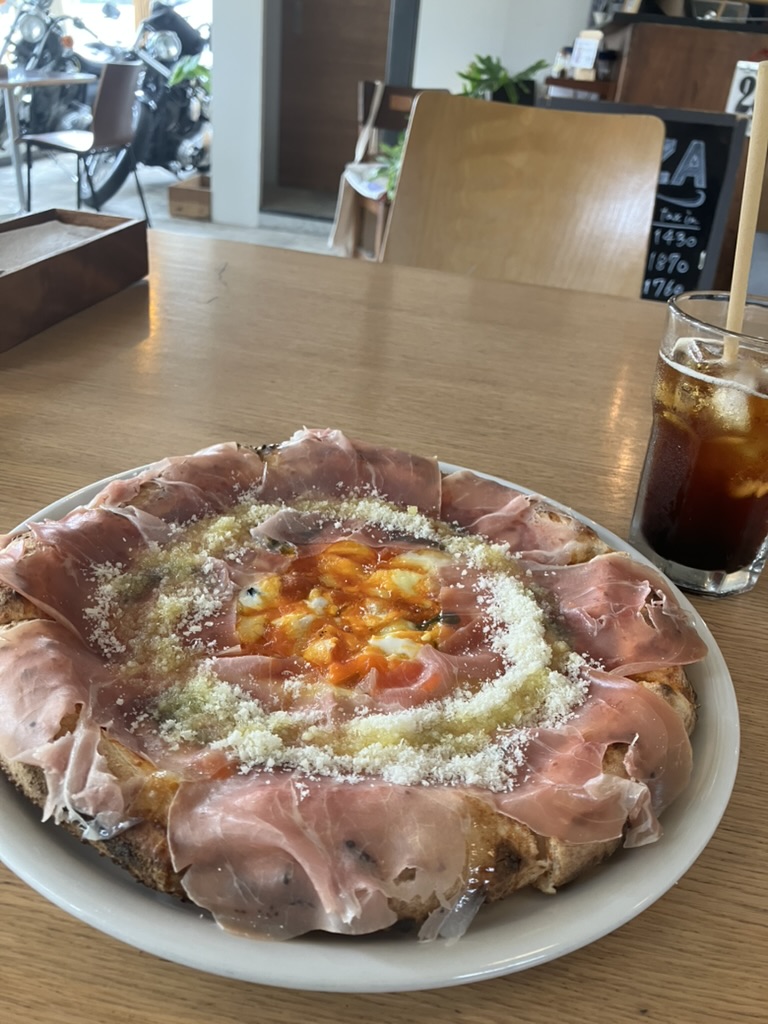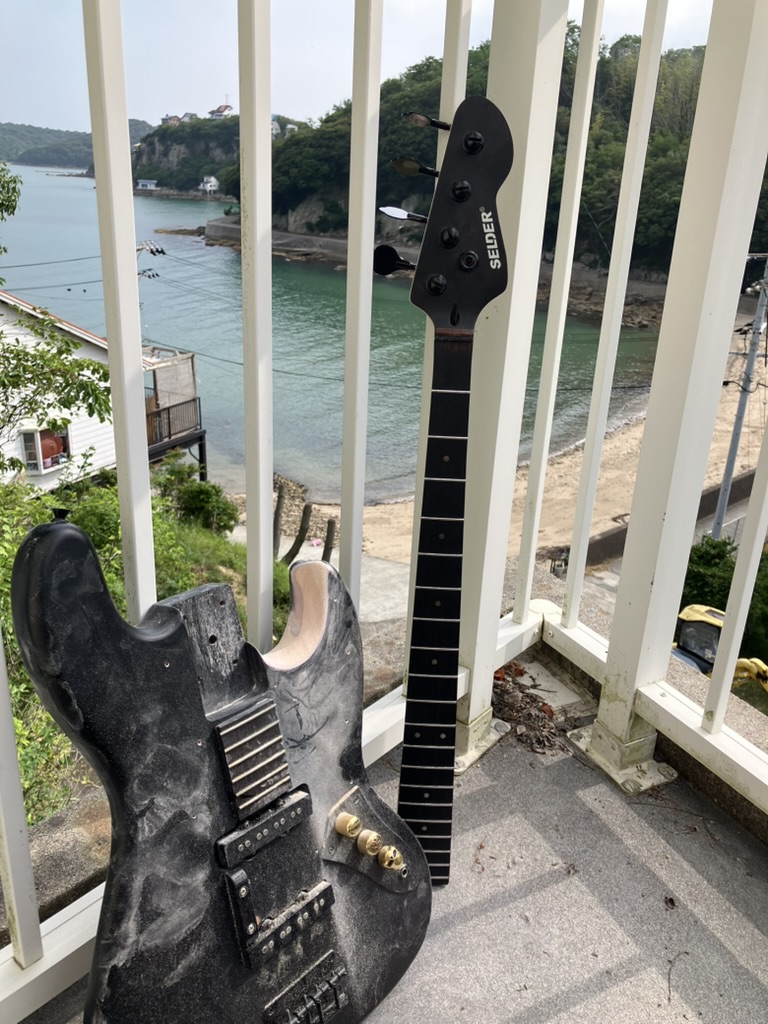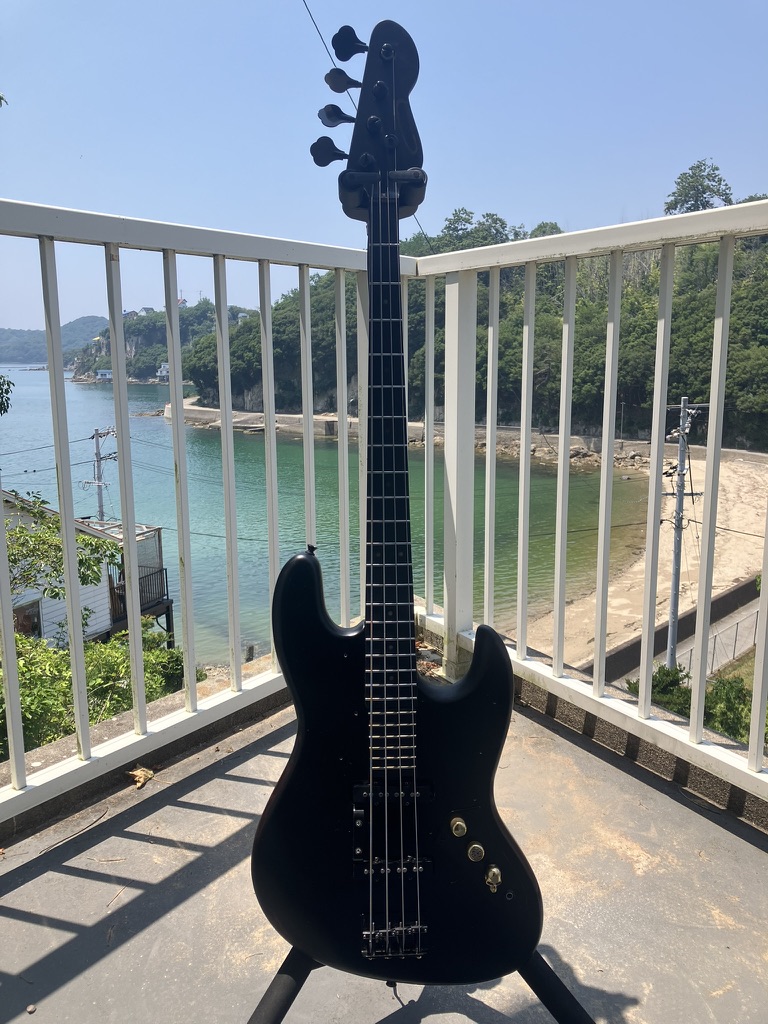-113-
It was the rainy season in Japan, and I had expected heavy rainfall even on Kojima. However, thanks to the mountain ranges surrounding the Seto Inland Sea, there were surprisingly few rain clouds. The weather was beautiful, and every morning I woke up to the view of the blue sea and sky. There were few guests staying on the island, and the cottage work wasn’t busy. On sunny days, I would wake up and immediately put on a wetsuit to swim or float in the sea. After that, I would practice, then leave home around 13:00 to catch the 13:15 ferry. I’d walk to the port and take a 15-minute ride across the sea to the mainland. The ocean is especially beautiful during this season. The island trees take on a deeper green, and the contrast with the blue water is striking. Around 13:30, I’d stop by my favorite pizza place to order a Margherita and coffee. After lunch, I’d head to a café with an ocean view, where I’d listen to music and work on various things until 16:00. Staying at home makes me want to pick up my instrument, so I deliberately pull myself away. I’d return to Kojima on the 16:40 ferry, head back home, and practice again. That was my daily routine.


Really amazing pizza restaurant:https://www.umitopizza.com/
It would have been nice if I could enjoy only the good parts of rural life, but of course, that wasn’t the case. The island is basically a party venue for insects. As the weather warmed up, I found myself dealing with swarms of winged ants sometimes around thirty of them, gathering near the windows at night, drawn to the light. Then there were sudden appearances of centipedes and cockroaches, and worst of all, fleas that are incredibly difficult to get rid of. When the flea problem first started, no matter how many I killed, they would still jump onto the bed, and I sometimes ended up fighting them all night long. After spraying pesticide from a mainland supermarket throughout the room and doing thorough cleanings, the number gradually started to go down. Still, red spots appeared all over my body, and the itching was so intense that there were days I couldn’t focus on practice. My skin became so covered in flea bites that the pigmentation changed. At one point, I also got stung by the hairs of a toxic moth caterpillar, and my entire body swelled up to the point where it felt like touching dragon scales.
One surprising discovery during all this was that after soaking in the ocean with my skin in such bad shape, the next day it would recover and feel incredibly smooth, almost like the surface of a boiled egg. The salt and minerals in the seawater seemed to have a healing effect on my skin. Once I realized this, I started repeating the same pattern almost every day: get attacked by fleas, then go for a swim in the sea. Lately, my skin has finally started to recover, as its healing ability has begun to outpace the total assault from the fleas.

i. Tomato sauce
ii. Fried eggs
iii. Bread from the local pizza shop
When I stick to eating only additive-free foods, my meals become much simpler.
Living surrounded by nature, I’ve come to realize just how troublesome insects can be. At the same time, I’ve developed some useful survival skills. These days, even when a cockroach or centipede appears in my room, I can handle the situation calmly in autopilot mode. One of my short-term goals is to live outdoors. I’ve been envisioning a lifestyle where I attach a camper to the back of my bicycle and live on the move, so learning how to deal with insects now will definitely come in handy later.
Improving Right-Hand Three-Finger Technique
In early June, I spent much of my time practicing at the beach. I avoided using backing tracks or a metronome and instead focused more on tapping my foot and being conscious of syncopation. At the same time, I was experimenting with the angle of my plucking fingers, trying to make them as parallel to the strings as possible to see if I could produce a bigger sound. I began practicing three-finger technique on electric bass around October 2024 and started applying it to the double bass from January 2025.
Through experimenting with various finger angles, I initially tried playing with my fingers at a ninety-degree angle to the strings, similar to Eddie Gomez. That approach worked reasonably well on electric bass, but I soon realized that the tone was too thin on the double bass. As an alternative, I started practicing with my fingers positioned more parallel to the strings. However, with this method, I found it nearly impossible to achieve the speed I wanted. When I forced the tempo, the motion felt much less natural than with two fingers, and adding accents with the index or middle finger became difficult.
Still, playing with the fingers parallel to the strings allows more of the finger surface area to contact the string, which produces a fuller sound. After closely observing Niels-Henning Ørsted Pedersen’s right-hand motion, I noticed that using more finger surface seems to be the only viable option. For that reason, I spent the latter half of June practicing open-string plucking with my right hand. Just this warm-up took about an hour each day. Looking back, I realized how little awareness I had given to my right hand until now, so in a way, I’m glad I finally caught on. If I had a teacher who could guide me through three-finger technique, I might have made faster progress without wasting time. But there are almost no such teachers in the world. Double bass pizzicato is typically done with two fingers; the index and middle, so using the ring finger as part of a three-finger system is quite rare.
Because of this, I often found myself practicing incorrectly, then realizing the mistake later, correcting it, only to repeat the cycle again. At times, I questioned whether I should continue down this path or give up and return to two fingers. Continuing without a clear sense of what is correct requires a kind of self-hypnosis, since one part of the brain must remain inactive in order to ignore the potential sunk costs of failure.
One thing that made me happy this month was noticing that I could finally play the kind of phrases I wanted on electric bass, and with reasonably stable syncopation. When I listened back to old recordings, the rhythm was unbearable. Double bass will take more time. I don’t know if it will be a few more months or longer, but I’m encouraged that the goal of mastering the technique is gradually coming into view.
Working seriously on three-finger technique has helped me realize how important the right hand is—more so than the left. For example, relaxing the left-hand fingering cannot be achieved simply by focusing on the left hand. When the right hand plucks the string with minimal energy, the left hand unconsciously adjusts and presses the string with just the amount of force needed for vibration. But when there is unnecessary tension in the right hand, the left hand cannot relax. This becomes especially clear when watching Brian Bromberg play. His right hand plucks the strings as if brushing them with a feather, completely relaxed.
Because I had to fundamentally rework my right-hand technique, it was difficult to maintain precise rhythm throughout June. I completely lost the desire to record myself. This may have been a month when I struggled to find the joy of playing the double bass.
Gear Update (Electric Bass: SELDER)
In May, I got a SELDER electric bass and recently modified the cutaway area. I cut a piece of fingerboard originally made for guitar and attached it to the bass to extend the upper register on the G string. However, because the SELDER’s cutaway was quite shallow, my left hand sometimes couldn’t reach the extended section. So I began filing it down patiently with 40-grit sandpaper, but even after several hours, the cutaway was not as deep as I had hoped.
I also applied this sanding process to the neck. When I first opened the box, the neck felt like a flat piece of wood with a fingerboard just stuck on top, there was barely any shaping. As a result, I needed to carefully file down the sides of the neck to refine its shape. The SELDER bass doesn’t have the kind of resonant sound you might expect from higher-quality materials, but despite that, I actually prefer the tone and feel of this instrument over my Yamaha TRB1004J.
Because the SELDER is inexpensive, I don’t feel any hesitation about modifying it. I’ve even drilled into the pickup area to install a finger rest, and I feel free to sand the body however I want. For coloring the fingerboard, body, and neck, I used regular black hair dye, the kind used for covering gray hairs.


Coltrane Changes
In July, I’ve been studying Coltrane changes, especially the tune Countdown. Ever since I first discovered this piece, I knew I would have to tackle it someday, and now I’m finally working on it. With six different key centers, it’s a song that lets you explore a wide range of keys, making it incredibly valuable for practice. Including Giant Steps, Coltrane changes require you to break down each phrase into its smallest components, which I believe makes them ideal for deeply internalizing key structures.
For example, before I started practicing Giant Steps, I used to feel uncomfortable in the key of B major. But since the changes force you to quickly figure out where to land and how to fit each note into the harmony, I ended up developing a well-rounded understanding of the diatonic elements in B major.
Music I Listened to This Month
This month, I was transcribing Charlie Parker’s Cherokee. There’s something almost unnatural about Bird’s solos. Not a single note feels wasted. While some musicians might push through with confidence even after a mistake, Bird seems to operate in a realm where mistakes simply don’t exist. Every phrase fits perfectly, like pieces of a puzzle snapping into place. That’s where I sense the mystery in his solos. The tone, rhythm, and articulation are all flawless. Each tune he created feels nothing short of a miracle.
I’ve also been listening to a lot of Chris Potter lately. His music is so dense with information that I end up spending the whole month listening to just a few tracks over and over. Every time, I’m struck by the vastness of his vocabulary, the flexibility with which he transforms his phrases, and his ability to modulate keys instantly. It’s also fascinating to hear occasional phrases that hint at his classical roots.